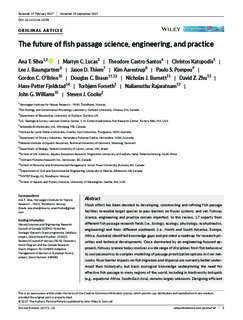The future of fish passage science, engineering, and practice
| dc.contributor.author | Silva, Ana T. | |
| dc.contributor.author | Lucas, Martyn C. | |
| dc.contributor.author | Castro-Santos, Theodore | |
| dc.contributor.author | Katopodis, Christos | |
| dc.contributor.author | Baumgartner, Lee J. | |
| dc.contributor.author | Thiem, Jason D. | |
| dc.contributor.author | Aarestrup, Kim | |
| dc.contributor.author | Pompeu, Paulo S. | |
| dc.contributor.author | O'Brien, Gordon C.O. | |
| dc.contributor.author | Braun, Douglas C. | |
| dc.contributor.author | Burnett, Nicholas J. | |
| dc.contributor.author | Zhu, David Z. | |
| dc.contributor.author | Fjeldstad, Hans-Petter | |
| dc.contributor.author | Forseth, Torbjørn | |
| dc.contributor.author | Rajaratnam, Nallamuthu | |
| dc.contributor.author | Williams, John G. | |
| dc.contributor.author | Cooke, Steven J. | |
| dc.date.accessioned | 2019-10-04T13:35:59Z | |
| dc.date.available | 2019-10-04T13:35:59Z | |
| dc.date.created | 2017-11-28T14:45:08Z | |
| dc.date.issued | 2017 | |
| dc.identifier.issn | 1467-2960 | |
| dc.identifier.uri | http://hdl.handle.net/11250/2620398 | |
| dc.description.abstract | Much effort has been devoted to developing, constructing and refining fish passage facilities to enable target species to pass barriers on fluvial systems, and yet, fishway science, engineering and practice remain imperfect. In this review, 17 experts from different fish passage research fields (i.e., biology, ecology, physiology, ecohydraulics, engineering) and from different continents (i.e., North and South America, Europe, Africa, Australia) identified knowledge gaps and provided a roadmap for research priorities and technical developments. Once dominated by an engineering-focused approach, fishway science today involves a wide range of disciplines from fish behaviour to socioeconomics to complex modelling of passage prioritization options in river networks. River barrier impacts on fish migration and dispersal are currently better understood than historically, but basic ecological knowledge underpinning the need for effective fish passage in many regions of the world, including in biodiversity hotspots (e.g., equatorial Africa, South-East Asia), remains largely unknown. Designing efficient ishways, with minimal passage delay and post-passage impacts, requires adaptive management and continued innovation. While the use of fishways in river restoration demands a transition towards fish passage at the community scale, advances in selective fishways are also needed to manage invasive fish colonization. Because of the erroneous view in some literature and communities of practice that fish passage is largely a proven technology, improved international collaboration, information sharing, method standardization and multidisciplinary training are needed. Further development of regional expertise is needed in South America, Asia and Africa where hydropower dams are currently being planned and constructed. dams, ecohydraulics, fish conservation, fish migration, fishway, standardization | nb_NO |
| dc.language.iso | eng | nb_NO |
| dc.publisher | Wiley | nb_NO |
| dc.rights | Navngivelse 4.0 Internasjonal | * |
| dc.rights.uri | http://creativecommons.org/licenses/by/4.0/deed.no | * |
| dc.title | The future of fish passage science, engineering, and practice | nb_NO |
| dc.type | Journal article | nb_NO |
| dc.type | Peer reviewed | nb_NO |
| dc.description.version | publishedVersion | nb_NO |
| dc.rights.holder | The Authors | nb_NO |
| dc.subject.nsi | VDP::Zoologiske og botaniske fag: 480 | nb_NO |
| dc.subject.nsi | VDP::Zoology and botany: 480 | nb_NO |
| dc.source.journal | Fish and Fisheries | nb_NO |
| dc.identifier.doi | 10.1111/faf.12258 | |
| dc.identifier.cristin | 1519686 | |
| dc.relation.project | EU/EU Amber 689682 | nb_NO |
| dc.relation.project | Andre: Natural Sciences and Engineering Research Council of Canada | nb_NO |
| dc.relation.project | Norges forskningsråd: 244022 | nb_NO |
| cristin.unitcode | 7548,50,0,0 | |
| cristin.unitname | Energisystemer | |
| cristin.ispublished | true | |
| cristin.fulltext | original | |
| cristin.qualitycode | 2 |
Tilhørende fil(er)
Denne innførselen finnes i følgende samling(er)
-
Publikasjoner fra CRIStin - SINTEF Energi [1614]
-
SINTEF Energi [1728]

